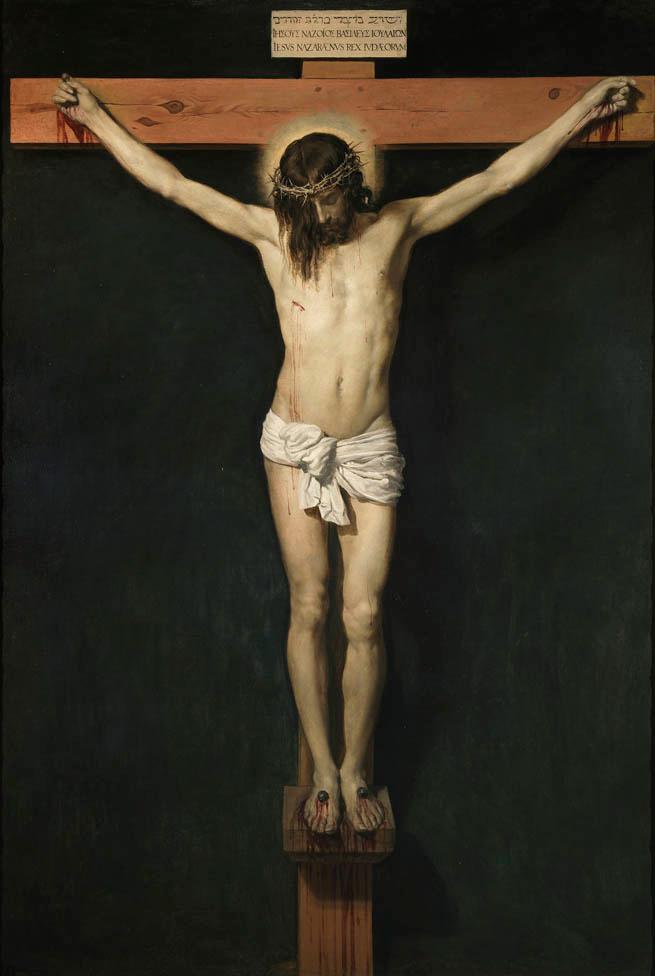Velázquez, Diego (1599-1660)
Cristo crucificado (Christ Crucified)
c.1632
Oil on canvas, 248 x 169 cm
Museo del Prado, Madrid
Stylistically, this work appears to have been made in the early 1630s -soon after the artist returned from Italy– and most authors date it from around 1632. The Apollonian perfection of the anatomy and the figure’s pale complexion recall the neo-Attic character of Guido Reni’s work, but it must have been Velázquez‘s intention to imbue the figure with a divine and ineffable beauty, reflecting the belief that Christ was the most beautiful of men. This idea is affirmed by one of the Messianic Psalms: Speciosus forma es prae filiis hominum [Thou art the most beautiful of the sons of men], Vulgate, Psalm 44 (45), 3). Francisco Pacheco emphasized Christ`s physical beauty, writing: Christ, Our lord, had no earthly father and thus completely resembled his Mother who, after him Him, was the most beautiful creature that God ever created. Four nails hold Christ on the cross, following the painterly formula that Pacheco began using in 1611 and that he defended with a number of historical and religious arguments that appear at the end of his Art of Painting from 1649. The cross itself was the work of a good carpenter, as Julián Gallego painted out, and the titulus appearing over Jesus’ head follows the Latin text from the Gospel of Saint John in the Vulgate (with a small error, NAZARAENVS rather than Nazarenus, as in Pacheco’s 1614 Crucifixion at the Fundación Rodríguez-Acosta in Granada. Velázquez also committed errors in his transcriptions of Hebrew and Greek). The presence of a wound in his side, which occurred after Christ’s death, indicates that he has already expired, yet he seems to be holding his body in check on the Cross, as if sweetly dreaming rather than having recently died in agony, as Bernardino de Pantorba eloquently put it.
The painting may have been commissioned for the Convent of San Plácido in Madrid by Jerónimo de Villanueva (1594-1653), who founded that convent in 1623 and was proto-notary of the Kingdom of Aragon as well as the Count-Duke of Olivares’ right-hand man. Villanueva’s standing in Court was sufficient to allow him to commission the King’s painter to make such an important work, and we know that he had some direct contact with Velázquez, as he was responsible for administering secret expenses, and had made some payments to that painter at the king’s behest in 1634 and 1645. It has been suggested that the canvas was commissioned in 1632 after the Inquisition suspended its investigation of Villanueva’s personal involvement with presumably irregular activities by the chaplain and nuns of San Plácido. Rodríguez G. de Ceballos has explained the peculiar turn of events that may have led to a commission with this choice of subject matter: while Villanueva was under investigation, the Court was scandalized by the profanation of a sculpted crucifix perpetrated by a group of Portuguese Jews in Madrid in 1630. The guilty parties were executed in 1632 following a grand auto da fe at Madrid‘s Plaza Mayor, and there were public acts of devotion to the crucified Christ at both the Alcázar and the royal convents. While Villanueva was not implicated in that trial, he was accused of favoring Jewish bankers from Portugal over their Genoese counterparts, which gained him influential enemies. Thus, his decision to commission Velázquez to paint a monumental crucifixion could be understood as a demonstration of piety, affirming his religious orthodoxy and publically distancing himself from the Jews. Whatever the case may be, there are indications that Villanueva had the Convent of San Plácido decorated with relevant artworks. Indeed, while Rubens was in Madrid between 1628 and 1629, Villanueva directly commissioned him to make a sketch for the painting intended to adorn the main altarpiece. Julius Held called this complex allegory The Incarnation as Fulfillment of All Prophecies (The Barnes Foundation, Merion, Pennsylvania; see Held, 1980, no. 319).
(Fábulas de Velázquez. Mitología e Historia Sagrada en el Siglo de Oro / edición a cargo de Javier Portús Pérez, Madrid, Museo Nacional del Prado, 2007, p.321)
